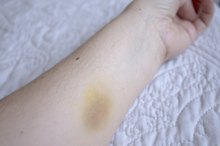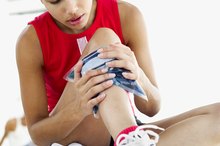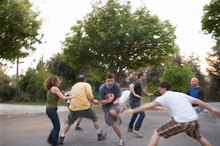How to Treat Direct Trauma to the Breast
Breast contusion occurs as a result of a direct blow to the breast from an object or another body part. When a blunt force is applied on the breast, it ruptures the small blood vessels, so there will be bleeding from the inside – resulting to bruising of the skin and underlying tissues. Males and females are both susceptible; and its symptoms include redness and pain on the breast or nipple, accompanied with swelling, tenderness, and discoloration (black and blue). The healing process of this type of injury differs in every individual depending on how bad the damage is. Presented below are the useful steps on how to treat an injured breast from a direct trauma.
Initial treatment using RICE an acronym that means R for rest, I for ice, C for compression and E for elevation.Rest the injured area immediately. Position the injured person in a comfortable manner to avoid further damage on the area. For example, when the victim is lying flat on the stomach after an impact on the breast, roll him/her safely to supine position.
Can You Pull Muscles in Your Breast?
Learn More
Ice application helps to reduce pain and swelling. Apply it around the breast area for 30 minutes. After this, stop the icing for about 15 minutes to allow the skin to get warm. Then do icing again for another 30 minutes, with the same 15 minutes warming. Do interval of icing and warming application for 3 hours.
Compression is a helpful technique to stop the bleeding of the breast and its surrounding tissues. You can use an elastic bandage, or any kind of cloth available, to apply compression. Wrap the injured part carefully; begin from the bottom of the injury and continue up to the area above it. Be careful not to wrap it too tight to avoid impeding the blood supply to the area. If the victim complains of numbness, increase in pain, cramping, or if you notice cyanosis is present, then carefully remove the bandage or cloth. Let the area rest for awhile until the signs of impaired circulation disappears. Wrap the area again, but this time try not to make it too tight.
What Are the Treatments for Breast Ligament Pain?
Learn More
Elevate the breast area to decrease pain and swelling. Place the victim in an inclined comfortable position with a firm support on the back.
Be sure to follow all the doctors’ orders to avoid doing something that may cause more damage.
Apply ice massage on the area. Do it in a circular motion around the breast for 15 minutes and do this 3-4 times a day.
After two days of icing, you can switch to heat application, to soothe the pain. You can just take a hot shower, soak yourself in a tub with warm water, or use heating pads.
For additional pain relief, take some pain killers such as ibuprofen (Advil) or acetaminophen. Do not take aspirin since this type of medication is prohibited for injuries with bleeding.
Get a lot of rest. This will promote relaxation and increase the process of healing.
Tips
For women who are into contact sports, wear a padded sports bra for protection. Do not apply ice directly into the skin. Place a towel or cloth above the area before proceeding with your application or put some ice cubes on a plastic bag and wrap it with a towel – to prevent ice burn.
Warnings
Go straight to your doctor if you experience the following: If swelling persist with in 2-3 days When signs of infections appear such as fever, chills, headache, dizziness, muscle pain, and puss around the breast area If the lump or nodules that form following the injury is still present after 2-3 months
Related Articles
References
- Goyal A. Breast pain. BMJ Clin Evid. 2014;2014:0812.
- Eren T, Aslan A, Ozemir IA, et al. Factors affecting mastalgia. Breast Care (Basel). 2016;11(3):188-93. doi:10.1159/000444359
- Kataria K, Dhar A, Srivastava A, Kumar S, Goyal A. A systematic review of current understanding and management of mastalgia. Indian J Surg. 2014;76(3):217-22. doi:10.1007/s12262-013-0813-8
- Cancer Research UK. Fibrocystic breast changes. September 20, 2017.
- Koo MM, von Wagner C, Abel GA, McPhail S, Rubin GP, Lyratzopoulos G. Typical and atypical presenting symptoms of breast cancer and their associations with diagnostic intervals: evidence from a national audit of cancer diagnosis. Cancer Epidemiol. 2017;48:140-6. doi:10.1016/j.canep.2017.04.010
- Cuhaci N, Polat SB, Evranos B, Ersoy R, Cakir B. Gynecomastia: Clinical evaluation and management. Indian J Endocrinol Metab. 2014;18(2):150-8. doi:10.4103/2230-8210.129104
- National Institute on Aging. Shingles. October 29, 2018.
- Jokich PM, Bailey L, D'Orsi C, et al. ACR appropriateness criteria breast pain. J Am Coll Radiol. 2017;14(5S):S25-33. doi:10.1016/j.jacr.2017.01.028
- American Cancer Society. American Cancer Society recommendations for the early detection of breast cancer. 2017.
Tips
- For women who are into contact sports, wear a padded sports bra for protection.
- Do not apply ice directly into the skin. Place a towel or cloth above the area before proceeding with your application or put some ice cubes on a plastic bag and wrap it with a towel – to prevent ice burn.
Warnings
- Go straight to your doctor if you experience the following:
- If swelling persist with in 2-3 days
- When signs of infections appear such as fever, chills, headache, dizziness, muscle pain, and puss around the breast area
- If the lump or nodules that form following the injury is still present after 2-3 months
Writer Bio
Wirnani Garner holds a Bachelor of Science degree in physical therapy and works in the medical profession. Her articles focus on health-related subjects, though Garner is proficient in researching and writing about a diverse range of topics.







